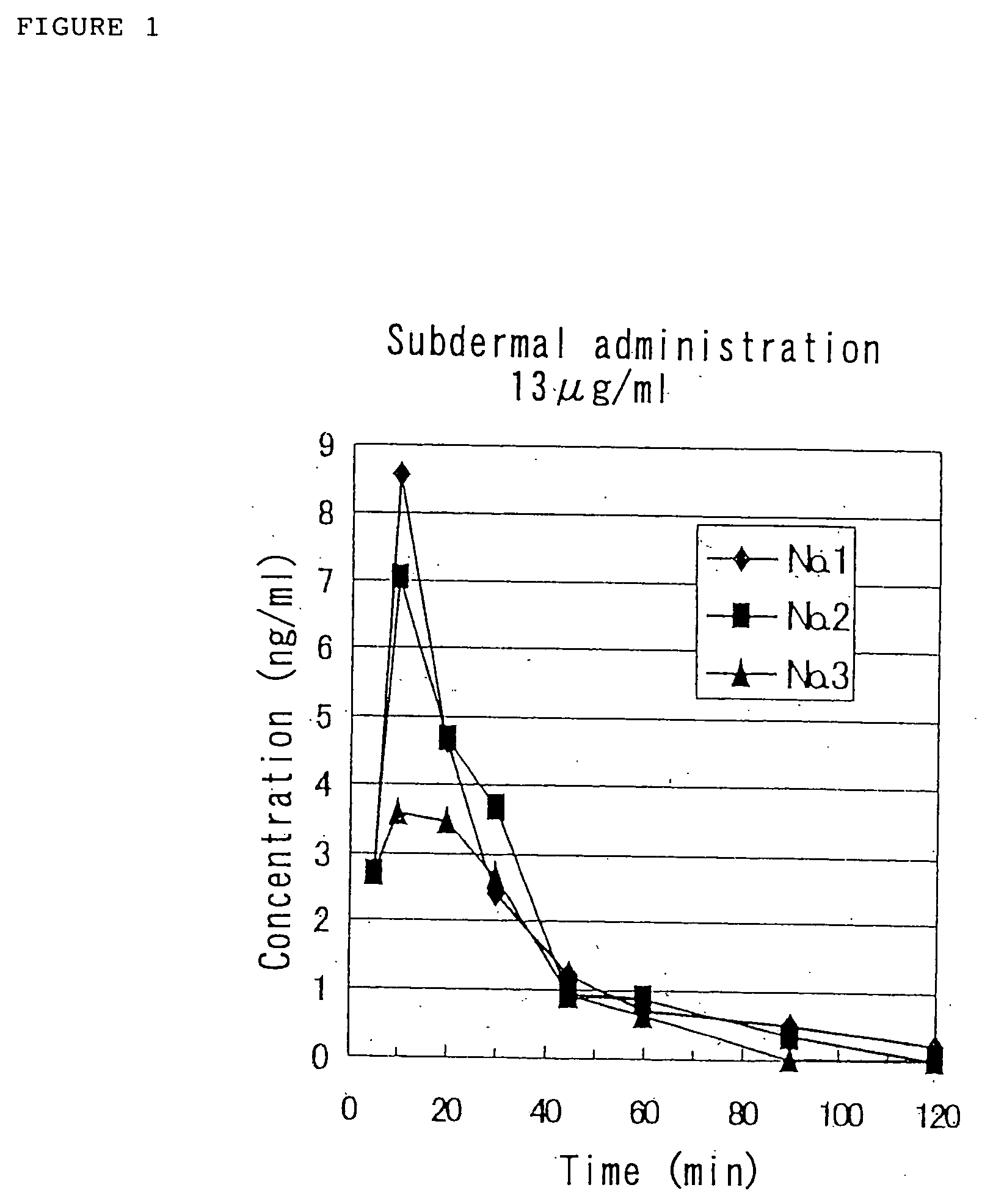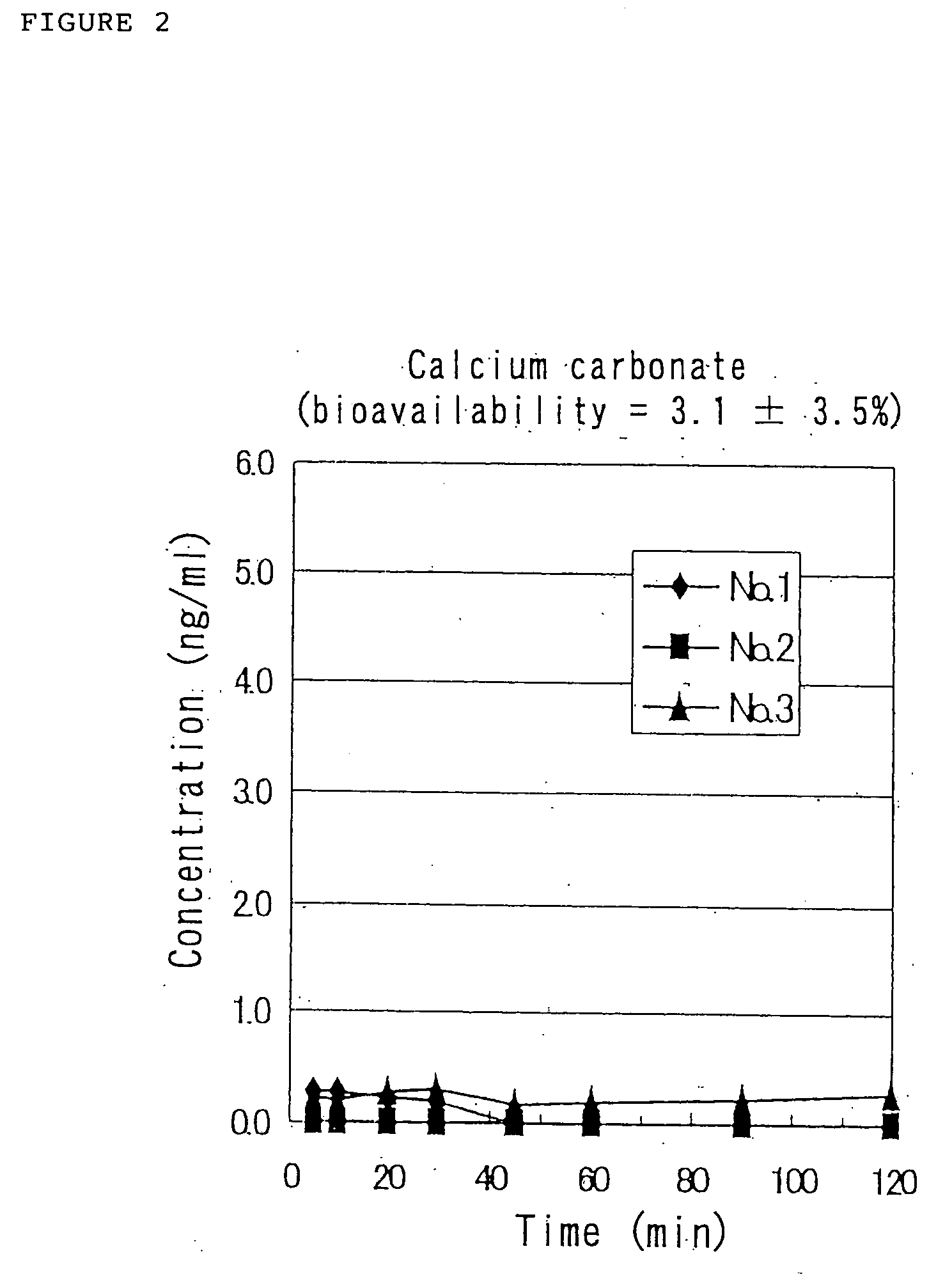Medicinal compositions for nasal absorption
a technology of compositions and medicaments, applied in the direction of inorganic non-active ingredients, peptide sources, metabolic disorders, etc., can solve the problems of excessive blood glucose level, inability to develop peptides, and inability to prolong the administration of medicaments for diabetes treatmen
- Summary
- Abstract
- Description
- Claims
- Application Information
AI Technical Summary
Benefits of technology
Problems solved by technology
Method used
Image
Examples
reference example 1
Preparation of GLP-1 (7-36)NH2
An expression plasmid pG97ompPR for expressing a fusion protein consisting of an Escherichia coli β-galactosidase derivative (β-gal 97), a 25 amino acid-long linker, and GLP-1 (7-37) was prepared (International Patent Publication No. WO99 / 38984). The linker region of the expressed fusion protein includes a cleavage motif for ompT protease (Arg-Arg) and a cleavage motif for Kex2 protease (Pro-Arg) and is cleaved by the proteases at the respective cleavage sites.
In order to obtain the fusion protein, pG97ompPR was introduced in an Escherichia coli strain descended from W3110 strain. The resultant transformants were incubated in a growth medium containing yeast extracts, inorganic salts, and glucose in a 300 L incubator. The cells were incubated until the concentration of the bacteria reached OD660=180. The resultant culture solution was processed in a high-pressure homogenizer to destroy cell bodies and then was centrifuged to collect the inclusion bo...
reference example 2
Test for Nasal Absorption of the Solution of GLP-1 (7-36)NH2 Pharmaceutical Composition Using Rats
About 10 mg of GLP-1 (7-36)NH2 obtained in Reference Example 1, 180 mg sucrose, 8 mg anhydrous citric acid, and 0.2 mg benzalkonium chloride were dissolved in 2 mL water to form a sample solution with a concentration of 5 mg / mL as measured by reversed-phase HPLC. Male SD rats, aged 7 to 9 weeks and weighing about 250 g (Crj: CD, Charles River Japan Inc.,), were kept in a metal cage with a day / night cycle of 12 hours while maintaining the temperature at 22±5° C. and the humidity at 30 to 70%. The rats were allowed to feed freely on solid feed and tap water and were fasted for 24 hours prior to the test (3 animals per group).
For nasal administration, a cannula was placed in the femoral artery under anesthesia with pentobarbital, and 5 μL of the sample solution was administered in the left nasal cavity with a precision pipette (about 100 μg / kg). The blood was collected into a tube cont...
reference example 3
Stability of the Solution of GLP-1 (7-36)NH2 Pharmaceutical Composition
The sample solution of GLP-1 (7-36)NH2 prepared in Reference Example 2 was stored at 25° C. and 40° C.
The results are shown in Table 2 below. As can be seen from the results, formation of small particles was observed after one week in each temperature condition.
TABLE 2Stability of GLP-1(7-36)NH2 aqueous solutionin 0.4% acetic acidTimeEvaluation25° C.40° C.InitialRemaining(100)(100)ProportionAppearanceClear and colorlessClear and colorlesspH2.802.80Week 1Remaining94.285.4ProportionAppearanceFine particle formedFine particle formedpH2.782.78Week 2Remaining88.577.3ProportionAppearanceFine particlesGelatedformedpH2.782.71
Peptide concentration: 5 mg / mL
0.4% anhydrous citric acid
9% sucrose
0.01% benzalkonium chloride
Although the results of Reference Example 2 indicate that the solution of the pharmaceutical composition containing GLP-1 (7-36)NH2 has the ability to be nasally absorbed in rats, the physicochemic...
PUM
| Property | Measurement | Unit |
|---|---|---|
| Particle size | aaaaa | aaaaa |
| Particle size | aaaaa | aaaaa |
| Particle size | aaaaa | aaaaa |
Abstract
Description
Claims
Application Information
 Login to View More
Login to View More - R&D
- Intellectual Property
- Life Sciences
- Materials
- Tech Scout
- Unparalleled Data Quality
- Higher Quality Content
- 60% Fewer Hallucinations
Browse by: Latest US Patents, China's latest patents, Technical Efficacy Thesaurus, Application Domain, Technology Topic, Popular Technical Reports.
© 2025 PatSnap. All rights reserved.Legal|Privacy policy|Modern Slavery Act Transparency Statement|Sitemap|About US| Contact US: help@patsnap.com



